EasyLanguage-Array
- 格式:pdf
- 大小:365.87 KB
- 文档页数:5
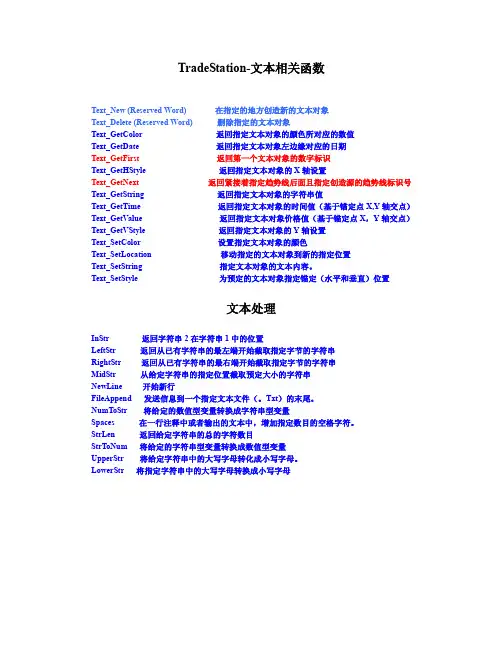
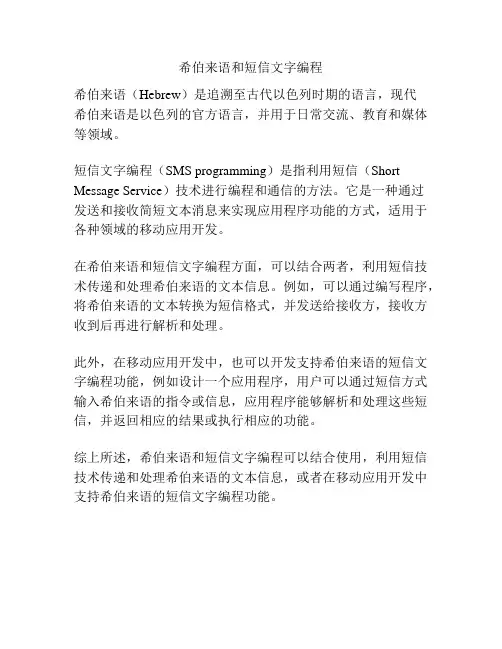
希伯来语和短信文字编程
希伯来语(Hebrew)是追溯至古代以色列时期的语言,现代
希伯来语是以色列的官方语言,并用于日常交流、教育和媒体等领域。
短信文字编程(SMS programming)是指利用短信(Short Message Service)技术进行编程和通信的方法。
它是一种通过
发送和接收简短文本消息来实现应用程序功能的方式,适用于各种领域的移动应用开发。
在希伯来语和短信文字编程方面,可以结合两者,利用短信技术传递和处理希伯来语的文本信息。
例如,可以通过编写程序,将希伯来语的文本转换为短信格式,并发送给接收方,接收方收到后再进行解析和处理。
此外,在移动应用开发中,也可以开发支持希伯来语的短信文字编程功能,例如设计一个应用程序,用户可以通过短信方式输入希伯来语的指令或信息,应用程序能够解析和处理这些短信,并返回相应的结果或执行相应的功能。
综上所述,希伯来语和短信文字编程可以结合使用,利用短信技术传递和处理希伯来语的文本信息,或者在移动应用开发中支持希伯来语的短信文字编程功能。
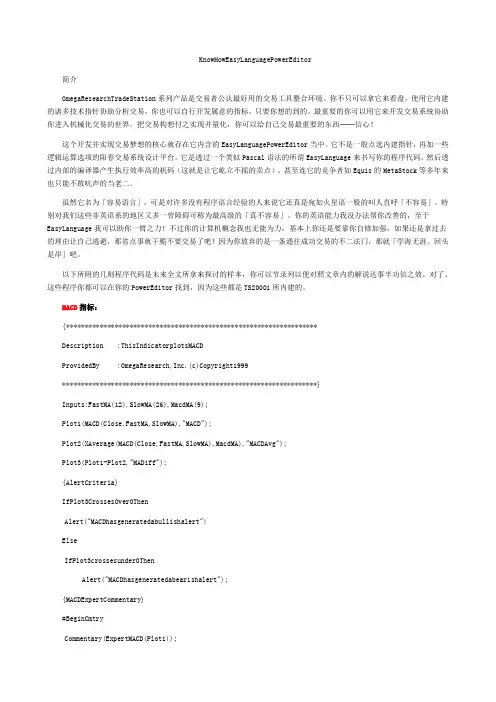
KnowHowEasyLanguagePowerEditor简介OmegaResearchTradeStation系列产品是交易者公认最好用的交易工具整合环境。
你不只可以拿它来看盘,使用它内建的诸多技术指针协助分析交易,你也可以自行开发属意的指标,只要你想的到的。
最重要的你可以用它来开发交易系统协助你进入机械化交易的世界。
把交易构想付之实现并量化,你可以给自己交易最重要的东西──信心!这个开发并实现交易梦想的核心就存在它内含的EasyLanguagePowerEditor当中。
它不是一般点选内建指针,再加一些逻辑运算选项的阳春交易系统设计平台。
它是透过一个类似Pascal语法的所谓EasyLanguage来书写你的程序代码,然后透过内部的编译器产生执行效率高的机码(这就是让它屹立不摇的卖点)。
甚至连它的竞争者如Equis的MetaStock等多年来也只能不敢吭声的当老二。
虽然它名为「容易语言」,可是对许多没有程序语言经验的人来说它还真是宛如火星语一般的叫人直呼「不容易」。
特别对我们这些非英语系的地区又多一曾障碍可称为最高级的「真不容易」。
你的英语能力我没办法帮你改善的,至于EasyLanguage我可以助你一臂之力!不过你的计算机概念我也无能为力,基本上你还是要靠你自修加强,如果还是拿过去的理由让自己逃避,那省点事就干脆不要交易了吧!因为你放弃的是一条通往成功交易的不二法门,那就「学海无涯、回头是岸」吧。
以下所附的几则程序代码是未来全文所拿来探讨的样本,你可以节录列以便对照文章内的解说达事半功倍之效。
对了、这些程序你都可以在你的PowerEditor找到,因为这些都是TS2000i所内建的。
MACD指标:{*******************************************************************Description :ThisIndicatorplotsMACDProvidedBy :OmegaResearch,Inc.(c)Copyright1999********************************************************************}Inputs:FastMA(12),SlowMA(26),MacdMA(9);Plot1(MACD(Close,FastMA,SlowMA),"MACD");Plot2(XAverage(MACD(Close,FastMA,SlowMA),MacdMA),"MACDAvg");Plot3(Plot1-Plot2,"MADiff");{AlertCriteria}IfPlot3CrossesOver0ThenAlert("MACDhasgeneratedabullishalert")ElseIfPlot3crossesunder0ThenAlert("MACDhasgeneratedabearishalert");{MACDExpertCommentary}#BeginCmtryCommentary(ExpertMACD(Plot1));#End;MACD函数之1:{******************************************************************* Description:MovingAverageConvergenceDivergenceProvidedBy:OmegaResearch,Inc.(c)Copyright1999********************************************************************} Inputs:Price(NumericSeries),FastMA(NumericSimple),SlowMA(NumericSimple); MACD=XAverage(Price,FastMA)-XAverage(Price,SlowMA);MACD函数之2{******************************************************************* Description:ExponentialAverageProvidedBy:OmegaResearch,Inc.(c)Copyright1999********************************************************************} Inputs:Price(NumericSeries),Length(NumericSimple);Variables:Factor(0);IfLength+1<>0ThenBeginIfCurrentBar<=1ThenBeginFactor=2/(Length+1);XAverage=Price;EndElseXAverage=Factor*Price+(1-Factor)*XAverage[1];End;MACD多头交易讯号{******************************************************************* Description :MACDLongEntryProvidedBy :OmegaResearch,Inc.(c)Copyright1999********************************************************************} Inputs:FastMovAvg(12),SlowMovAvg(26),MACDMovAvg(9);Variables:XMACD(0);IfCurrentBar>2ANDMACD(Close,FastMovAvg,SlowMovAvg)CrossesAboveXAverage(MACD(Close,FastMovAvg,SlowMovAvg ),MACDMovAvg)[1]ThenBuy("MACD")ThisBaronClose;MACD空头交易讯号{*******************************************************************Description :MACDShortEntryProvidedBy :OmegaResearch,Inc.(c)Copyright1999********************************************************************}Inputs:FastMovAvg(12),SlowMovAvg(26),MACDMovAvg(9);IfCurrentBar>2ANDMACD(Close,FastMovAvg,SlowMovAvg)CrossesBelowXAverage(MACD(Close,FastMovAvg,SlowMovAvg ),MACDMovAvg)[1]ThenSell("MACD")ThisBaronClose;待续第一章:指标写作现在开始我会逐行解说每一行程序代码的意义。
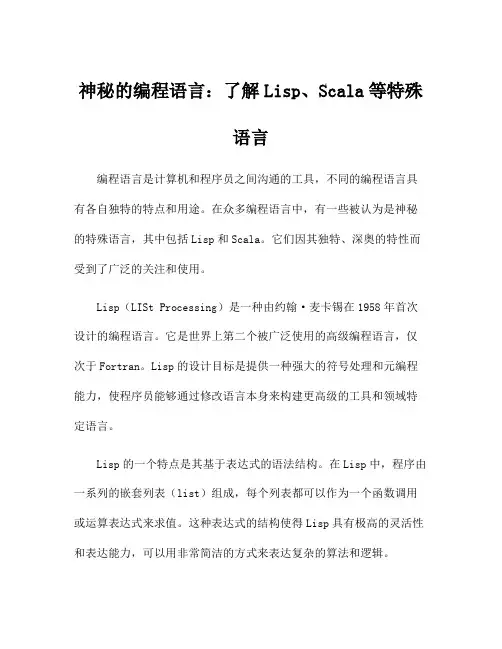
神秘的编程语言:了解Lisp、Scala等特殊语言编程语言是计算机和程序员之间沟通的工具,不同的编程语言具有各自独特的特点和用途。
在众多编程语言中,有一些被认为是神秘的特殊语言,其中包括Lisp和Scala。
它们因其独特、深奥的特性而受到了广泛的关注和使用。
Lisp(LISt Processing)是一种由约翰·麦卡锡在1958年首次设计的编程语言。
它是世界上第二个被广泛使用的高级编程语言,仅次于Fortran。
Lisp的设计目标是提供一种强大的符号处理和元编程能力,使程序员能够通过修改语言本身来构建更高级的工具和领域特定语言。
Lisp的一个特点是其基于表达式的语法结构。
在Lisp中,程序由一系列的嵌套列表(list)组成,每个列表都可以作为一个函数调用或运算表达式来求值。
这种表达式的结构使得Lisp具有极高的灵活性和表达能力,可以用非常简洁的方式来表达复杂的算法和逻辑。
除了基于表达式的语法结构,Lisp还引入了一种被称为S表达式(S-expression)的数据表示形式。
S表达式是一种将符号和列表组合起来的方式,可以表示各种数据结构和程序代码。
这种数据表示形式赋予了Lisp强大的元编程能力,使得程序可以通过操作语言本身来实现自定义的编程语言扩展和代码转换。
Lisp的强大和灵活性使其在人工智能、符号计算和自然语言处理等领域得到广泛应用。
Lisp的方言Scheme在学术界和教育领域也非常受欢迎。
另一个神秘的编程语言是Scala。
Scala是一种功能强大的多范式编程语言,它结合了面向对象编程和函数式编程的特性。
Scala最早由马丁·奥德斯基在2001年设计并开发,它的目标是充分利用Java虚拟机(JVM)的优势,并提供一种更简洁、更灵活的编程语言。
Scala的特点之一是其面向对象编程支持的强大和灵活。
与Java不同,Scala允许程序员使用更简洁、更优雅的方式来定义类和对象,并支持一些高级的面向对象编程特性,如模式匹配和混入(mixin)等。
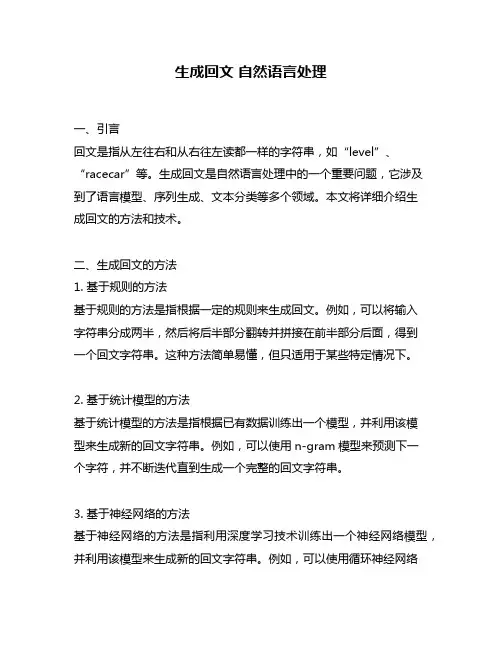
生成回文自然语言处理一、引言回文是指从左往右和从右往左读都一样的字符串,如“level”、“racecar”等。
生成回文是自然语言处理中的一个重要问题,它涉及到了语言模型、序列生成、文本分类等多个领域。
本文将详细介绍生成回文的方法和技术。
二、生成回文的方法1. 基于规则的方法基于规则的方法是指根据一定的规则来生成回文。
例如,可以将输入字符串分成两半,然后将后半部分翻转并拼接在前半部分后面,得到一个回文字符串。
这种方法简单易懂,但只适用于某些特定情况下。
2. 基于统计模型的方法基于统计模型的方法是指根据已有数据训练出一个模型,并利用该模型来生成新的回文字符串。
例如,可以使用n-gram模型来预测下一个字符,并不断迭代直到生成一个完整的回文字符串。
3. 基于神经网络的方法基于神经网络的方法是指利用深度学习技术训练出一个神经网络模型,并利用该模型来生成新的回文字符串。
例如,可以使用循环神经网络(RNN)或变换器(Transformer)等模型来进行序列生成。
三、生成回文的技术1. 语言模型语言模型是指对自然语言的概率分布进行建模的技术。
在生成回文中,语言模型可以用来预测下一个字符或单词,并根据预测结果生成新的回文字符串。
2. 序列生成序列生成是指根据已有数据生成新的序列数据的技术。
在生成回文中,序列生成可以用来根据输入字符串生成一个新的回文字符串。
3. 文本分类文本分类是指将一段文本分为不同类别的技术。
在生成回文中,文本分类可以用来判断一个字符串是否为回文,并根据判断结果进行后续处理。
四、应用场景1. 文字游戏在文字游戏中,经常需要玩家输入一些特定规则下的回文字符串。
利用自然语言处理技术可以快速地生成满足要求的回文字符串,提高游戏体验。
2. 文章标题在撰写文章时,一个好的标题可以吸引读者眼球并提高阅读量。
利用自然语言处理技术可以快速地生成有趣、富有创意且符合规范的文章标题。
3. 机器翻译在机器翻译中,经常需要将源语言翻译成目标语言,并保持原始语言的语法、结构和意思。
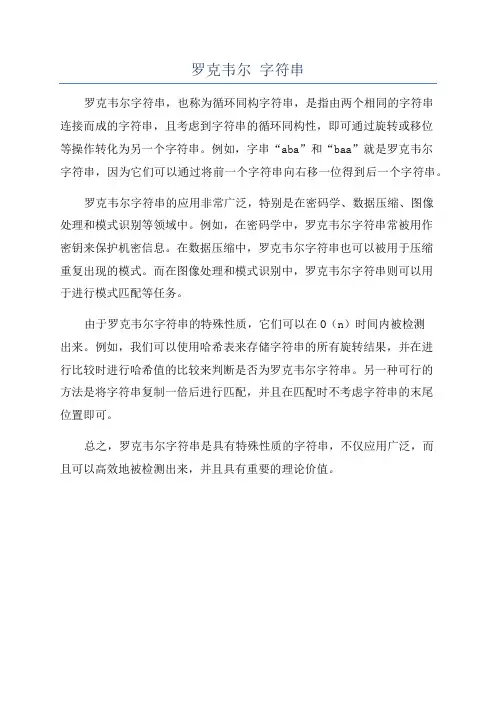
罗克韦尔字符串
罗克韦尔字符串,也称为循环同构字符串,是指由两个相同的字符串
连接而成的字符串,且考虑到字符串的循环同构性,即可通过旋转或移位
等操作转化为另一个字符串。
例如,字串“aba”和“baa”就是罗克韦尔
字符串,因为它们可以通过将前一个字符串向右移一位得到后一个字符串。
罗克韦尔字符串的应用非常广泛,特别是在密码学、数据压缩、图像
处理和模式识别等领域中。
例如,在密码学中,罗克韦尔字符串常被用作
密钥来保护机密信息。
在数据压缩中,罗克韦尔字符串也可以被用于压缩
重复出现的模式。
而在图像处理和模式识别中,罗克韦尔字符串则可以用
于进行模式匹配等任务。
由于罗克韦尔字符串的特殊性质,它们可以在O(n)时间内被检测
出来。
例如,我们可以使用哈希表来存储字符串的所有旋转结果,并在进
行比较时进行哈希值的比较来判断是否为罗克韦尔字符串。
另一种可行的
方法是将字符串复制一倍后进行匹配,并且在匹配时不考虑字符串的末尾
位置即可。
总之,罗克韦尔字符串是具有特殊性质的字符串,不仅应用广泛,而
且可以高效地被检测出来,并且具有重要的理论价值。
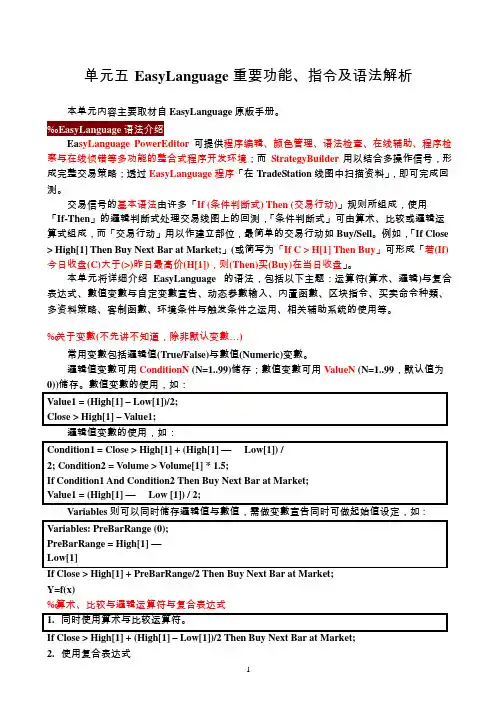
单元五EasyLanguage 重要功能、指令及语法解析本单元内容主要取材自EasyLanguage 原版手册。
Ea syLanguage PowerEditor 可提供程序编辑、颜色管理、语法检查、在线辅助、程序检察与在线侦错等多功能的整合式程序开发环境;而StrategyBuilder 用以结合多操作信号,形成完整交易策略;透过EasyLanguage 程序「在TradeStation 线图中扫描资料」,即可完成回测。
交易信号的基本语法由许多「If (条件判断式) Then (交易行动)」规则所组成,使用「If-Then」的邏辑判断式处理交易线图上的回测,「条件判断式」可由算术、比较或邏辑运算式组成,而「交易行动」用以作建立部位,最简单的交易行动如Buy/Sell。
例如,「If Close > High[1] Then Buy Next Bar at Market;」(或简写为「If C > H[1] Then Buy」可形成「若(If)今日收盘(C)大于(>)昨日最高价(H[1]),则(Then)买(Buy)在当日收盘」。
本单元将详细介绍EasyLanguage 的语法,包括以下主题:运算符(算术、邏辑)与复合表达式、數值变數与自定变數宣告、动态參數输入、内置函數、区块指令、买卖命令种類、多资料策略、客制函數、环境条件与触发条件之运用、相关辅助系统的使用等。
‰关于变數(不先讲不知道,除非默认变數…)常用变數包括邏辑值(True/False)与數值(Numeric)变數。
邏辑值变數可用ConditionN (N=1..99)储存;數值变數可用ValueN (N=1..99,默认值为0))储存。
數值变數的使用,如:Value1 = (High[1] – Low[1])/2;Close > High[1] – Value1;邏辑值变數的使用,如:Condition1 = Close > High[1] + (High[1] –Low[1]) /2; Condition2 = Volume > Volume[1] * 1.5;If Condition1 And Condition2 Then Buy Next Bar at Market;Value1 = (High[1] –Low [1]) / 2;Variables 则可以同时储存邏辑值与數值,需做变數宣告同时可做起始值设定,如:Variables: PreBarRange (0);PreBarRange = High[1] –Low[1]If Close > High[1] + PreBarRange/2 Then Buy Next Bar at Market;Y=f(x)‰算术、比较与邏辑运算符与复合表达式1. 同时使用算术与比较运算符。
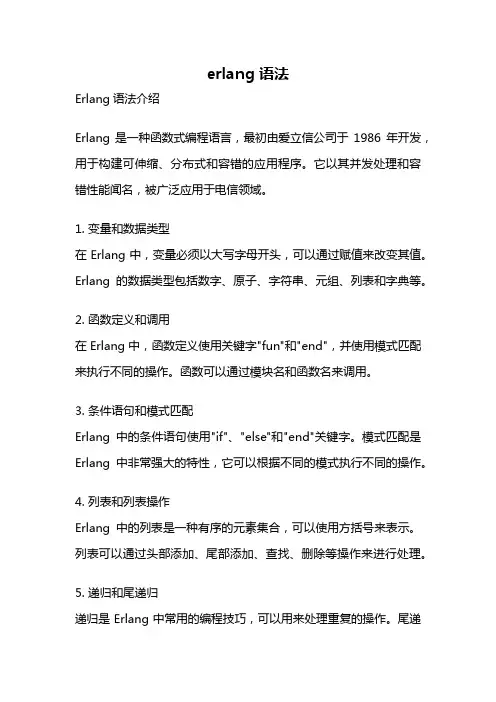
erlang 语法Erlang语法介绍Erlang是一种函数式编程语言,最初由爱立信公司于1986年开发,用于构建可伸缩、分布式和容错的应用程序。
它以其并发处理和容错性能闻名,被广泛应用于电信领域。
1. 变量和数据类型在Erlang中,变量必须以大写字母开头,可以通过赋值来改变其值。
Erlang的数据类型包括数字、原子、字符串、元组、列表和字典等。
2. 函数定义和调用在Erlang中,函数定义使用关键字"fun"和"end",并使用模式匹配来执行不同的操作。
函数可以通过模块名和函数名来调用。
3. 条件语句和模式匹配Erlang中的条件语句使用"if"、"else"和"end"关键字。
模式匹配是Erlang中非常强大的特性,它可以根据不同的模式执行不同的操作。
4. 列表和列表操作Erlang中的列表是一种有序的元素集合,可以使用方括号来表示。
列表可以通过头部添加、尾部添加、查找、删除等操作来进行处理。
5. 递归和尾递归递归是Erlang中常用的编程技巧,可以用来处理重复的操作。
尾递归是一种特殊的递归形式,可以避免堆栈溢出的问题。
6. 模块和导出函数Erlang中的模块用于组织函数和数据,模块可以通过"module"关键字进行定义。
模块可以导出函数,使其可以被其他模块调用。
7. 进程和消息传递Erlang是一种基于进程的编程语言,进程是Erlang并发性的基本单元。
进程之间通过消息传递进行通信,可以通过发送和接收消息来实现进程间的交互。
8. 错误处理和异常Erlang提供了强大的错误处理和异常处理机制。
可以使用"try"、"catch"和"after"关键字来捕获和处理异常,使程序具备容错性。
9. 并发和并行Erlang在语言层面提供了原生的并发支持,可以轻松地创建和管理大量的并发进程。
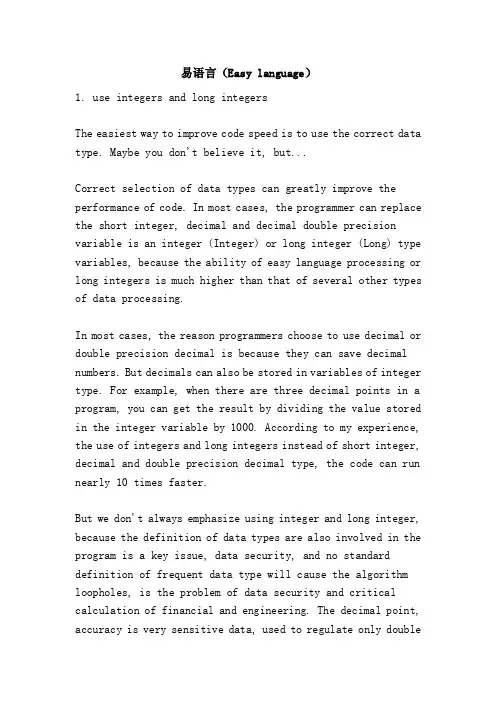
易语言(Easy language)1. use integers and long integersThe easiest way to improve code speed is to use the correct data type. Maybe you don't believe it, but...Correct selection of data types can greatly improve the performance of code. In most cases, the programmer can replace the short integer, decimal and decimal double precision variable is an integer (Integer) or long integer (Long) type variables, because the ability of easy language processing or long integers is much higher than that of several other types of data processing.In most cases, the reason programmers choose to use decimal or double precision decimal is because they can save decimal numbers. But decimals can also be stored in variables of integer type. For example, when there are three decimal points in a program, you can get the result by dividing the value stored in the integer variable by 1000. According to my experience, the use of integers and long integers instead of short integer, decimal and double precision decimal type, the code can run nearly 10 times faster.But we don't always emphasize using integer and long integer, because the definition of data types are also involved in the program is a key issue, data security, and no standard definition of frequent data type will cause the algorithm loopholes, is the problem of data security and critical calculation of financial and engineering. The decimal point, accuracy is very sensitive data, used to regulate only doubleprecision data. In addition, for integer will lead to the readability of the program declined sharply.2. avoid using generic dataA generic variable requires 16 bytes of space to store data, and an integer (Integer) requires only 2 bytes. Usually, the purpose of using universal variables is to reduce the amount of work and the amount of code to design, and some programmers use it in a simple way. However, if a software has been rigorously designed and coded according to specifications, the variant type can be avoided completely.3. avoid using attributes as much as possibleIn the usual code, the most common, inefficient code is the repeated use of attributes (Property), especially in loops, when variables can be used. You know, the speed of the access variable is about 20 times the speed of the access attribute. The following code is used by many programmers in the program:Container name: numeric type: integer typeContainer name: container type: integer typeCounter cycle head (7, container)Text 1. text content = 1. + content + text (# newline (numerical * container))Counting cycle tail ()The following code is 20 times faster than the previous code.Container name: numeric type: integer typeContainer name: container type: integer typeContainer name: Text Type: text typeText = text 1. contentCounter cycle head (7, container)Text = + text + text (# newline (numerical * container))Counting cycle tail ()Text 1. content = textIn addition, this involves a programming idea, using attributes as variables, most cases can simplify the algorithm. So sometimes you can't just emphasize replacing attributes with variables.6. avoid calling very short subroutinesCalling subroutines with only a few lines of code is also uneconomical - the time spent in calling subroutines may take longer than the code in the subroutine. In this case, you can copy the code in the subroutine to the place where the subroutine was called.But sometimes a small subroutine can be called many times, not only two or three times, and then it should be called.7. reduce the reference to the child objectIn easy language, the object is referenced by using. For example:Window 1. edit box 1.In the example above, the program refers to two objects: window 1 and edit box 1. The efficiency of using this method is very low. But unfortunately,There is no way to avoid it. My "multimedia module" has this shortcoming.8. check whether the text data is emptyMost easy language users use the following method when checking whether text data is empty:If (text 1. content = "")Notes: execution operationsEnd ifUnfortunately, the amount of processing required for string comparisons is even greater than the read attributes. So Isuggest you use the following methods:If (to numerical value (text 1. content) = 0)Notes: execution operationsEnd ifAnother difference is that the problem is that when the text string is a non numeric type such as "ABC", the numeric value ("ABC") =0 is not empty. Text comparison efficiency is not low, in the bottom of the algorithm, usually will directly compare the length will continue to compare content.9. use arrays, not multiple variablesWhen you have multiple variables that store similar data, you can think of replacing them with an array. Arrays are one of the most efficient data structures in an easy language.10. try to use dynamic arrays instead of static arraysUsing dynamic arrays does not have much impact on the execution speed of code, but in some cases it can save a lot of resources.11. destroy objectsNo matter what software is written, programmers need to consider releasing the memory space occupied by the software when the user decides to terminate the software running. Unfortunately, many users don't seem to care much about it. Thecorrect thing is to destroy the objects used in the program before exiting the program. For example: close the database: close (database name), all closed (), close the open (play) files, close the loaded pictures and so on.Suspend program execution should be to close the open file (including database files, image files, etc.) but destroywindow is automatic to destroy the window and window units, have enough to do with the release of the window, best not to destroy the window unit, may cause potential unit data access program in the collapse. Only in the graphic buffer to often destroy.12. use internal subroutines as much as possible to reduce the number of easy modulesBecause it is expensive to connect to an external object from an easy language, it takes a lot of CPU processing capability. Every time you call an interface function, you waste a lot of system resources.In addition, it is only when the interface function or variable is called in the easy module that the easy language is loaded into the memory; when the easy language application exits, the modules are unloaded from memory. If the code is only one module, easy language will only make a load operation, the efficiency of this code is improved; if the code has a number of modules, easy language to conduct multiple loading operation, it will decrease the efficiency of code.13. use object arrayWhen designing user interfaces, programmers should use object arrays as much as possible for the same type of control. You can do an experiment: add 100 picture boxes on the window, each picture box has a different name, run the program. Then create a new project, and add 100 picture boxes on the window, but this time use the object array, run the program, you can notice the difference between the two program loading time.Some people think that the logic of efficiency should be almost the same.14. use window unit "move" methodSome users prefer to use the "width", "height", "top edge" and "left" attributes when changing the position of the object. For example:Button 1. width = 100Button 1. height = 100Button 1. top edge = 0Button 1. left = 0In fact, this is inefficient because the program modifies four properties and the window is redrawn after each modification. The correct approach is to use the Move method:Button 1. move (0,0100100)FifteenReduce the use of picturesPictures will take up a lot of memory, and processing pictures also takes up a lot of CPU resources. In software, if possible, consider the background color instead of the picture - of course, this is only from the technical point of view to see this problem.However, in order to optimize the program interface, the benefits of using graphics may be better than the savings of resources, otherwise there will be no XP, there will be no progress in the game.16. compiler optimizationEasy language program compiler has three options: "compile", "independent compilation", "compile, generate, install, install software"". The preferred order should be "compiled installation software" and "compile" and "independent compilation", for "independent compilation" will be easy language support library system all are compiled into "compiler installation software only program compiled the necessary support library. If you want to run away from an easy language environment, you can not use "compile", and apply "compile and build installation software" or "independent compilation"".Sum up: executive efficiency and procedural readability are always contradictory, both should be consideredcomprehensively; resource occupancy and procedural ease of use are always contradictory, and both should be considered comprehensively. Based on this, we discuss some rules to improve the efficiency of the program.[rule 1] do not blindly pursue the efficiency of the program, and should try to improve the efficiency of the program on the premise of meeting the quality factors such as correctness, reliability, robustness and readability.[rule 2] in order to improve the overall efficiency of the program, and improve the local efficiency as a supplement.[rule 3] in order to optimize the efficiency of the program, the bottleneck of limiting efficiency should be found first, and the optimization should not be made irrelevant.[Rule 4] optimize data structures and algorithms first, and then optimize execution code. First consider whether a function can be implemented with function (command), if not found such a function, and then consider using other code to achieve.[Rule 5] Sometimes the time efficiency and the spatial efficiency may be antagonistic. At this point, we should analyze that more important and make the right compromise. For example, spending more memory to improve performance.[rule 6] do not always pursue compact code at all times, because compact code does not produce efficient machine code.。
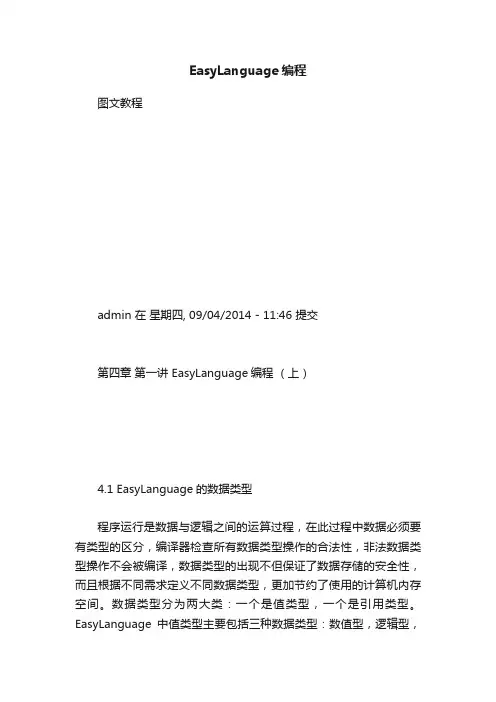
EasyLanguage编程图文教程admin 在星期四, 09/04/2014 - 11:46 提交第四章第一讲 EasyLanguage编程(上)4.1 EasyLanguage的数据类型程序运行是数据与逻辑之间的运算过程,在此过程中数据必须要有类型的区分,编译器检查所有数据类型操作的合法性,非法数据类型操作不会被编译,数据类型的出现不但保证了数据存储的安全性,而且根据不同需求定义不同数据类型,更加节约了使用的计算机内存空间。
数据类型分为两大类:一个是值类型,一个是引用类型。
EasyLanguage中值类型主要包括三种数据类型:数值型,逻辑型,字符型。
引用类型主要为数组类型。
EasyLanguage开发语言值类型包含三种主要数据类型,分别为1)数值型(Numeric)数值型又细分为三种不同精度的数据类型,分别为类型位数范围整型(Int)32-2,147,483,648 到 2,147,483,647长整型(Int64)64-9,223,372,036,854,775,808 到9,223,372,036,854,775,807单精度浮点型(Float)32-3.40E+38到 +3.40E+38双精度浮点型(Double)64-1.79E+308到 +1.79E+3082)逻辑型(Bool)逻辑型数据类型,又称为布尔型。
用Bool保留字来声明布尔类型变量,真值为True,假值为False。
3)字符型(String)字符型又称文本型。
用String保留字来声明字符串类型的变量。
如: Var:String ("Hello");这样就声明了一个“Hello”的字符串。
EasyLanguage开发语言中引用数据类型主要为数组类型,声明数组类型变量时,使用Array保留字来声明。
详细内容我们会在下一小节中介绍。
4.2 参数、变量、数组的定义与使用在程序设计的过程中,数据是以变量的方式存储的,无论何种程序设计语言,变量是构成一个程序的最基本元素。

易语言提取文本数值全文共四篇示例,供读者参考第一篇示例:易语言是一种流行的编程语言,广泛应用于软件开发和编程教育中。
在易语言中,我们经常需要从文本中提取出数字,进行各种数值计算或处理。
本文将介绍如何使用易语言提取文本中的数值,并展示一些实际应用场景。
我们需要了解一下文本中的数值是如何表示的。
在易语言中,数值通常以数字和/或小数点的形式出现,可能包含正负号、千位分隔符或者科学计数法等形式。
我们需要根据这些特征来提取出文本中的数值。
一种常见的方法是使用正则表达式来进行文本匹配和提取。
正则表达式是一种强大的文本处理工具,可以帮助我们快速准确地找到所需的文本片段。
在易语言中,我们可以使用内置的正则表达式函数来实现这一功能。
如果我们需要从一个字符串中提取出所有的数字,我们可以使用类似如下的正则表达式:```正则表达式(\+|-)?\d+(\.\d+)?```这个正则表达式可以匹配包含正负号以及小数点的数字。
通过将这个正则表达式应用到文本中,我们就可以得到文本中的所有数值。
下面是一个简单的示例代码,演示了如何使用正则表达式在易语言中提取文本中的数值:```易语言#coding=gbk#include <系统.h>#include <标准操作集.h>#include <正则表达式.h>// 定义一个函数来提取文本中的数值function extractNumbers(s: string): stringbegin// 定义一个正则表达式对象var r: TRegex// 编译正则表达式pile('(\+|-)?\d+(\.\d+)?')// 使用正则表达式匹配文本var matches: TRegexMatchListmatches = r.Matches(s)// 遍历匹配结果,并将其拼接成一个字符串var result: stringresult = ''for m in matchesbeginresult = result + m.Valueendreturn resultend// 主程序begin// 测试数据var text: stringtext = '这是一个测试文本,包含123.45个数字,-67.8还有一些其他的文字。
使用scala滨蟹函数过滤文本中的回文单词-回复如何使用Scala函数来过滤文本中的回文单词回文单词指的是从前往后和从后往前拼写都一样的单词,例如"level"和"radar"都是回文单词。
在本文中,我们将介绍如何使用Scala滨蟹函数来过滤文本中的回文单词。
滨蟹是一种高阶函数,它接受一个谓词函数作为参数,并在满足谓词函数的条件下,返回一个新的列表。
首先,我们需要定义一个用于判断一个单词是否为回文单词的谓词函数。
在Scala中,我们可以使用反转字符串的方法来判断一个字符串是否和它的反转相等。
下面是一个判断回文单词的函数示例:scaladef isPalindrome(word: String): Boolean = {word == word.reverse}接下来,我们需要使用文本处理库(如Apache Commons IO)来读取文本文件,并将文件中的内容存储在一个列表中,其中每个元素表示文件中的一行文本。
scalaimport java.io.Fileimport org.apachemons.io.FileUtilsval lines: List[String] = FileUtils.readLines(newFile("path/to/textfile.txt"), "UTF-8").toList通过上述代码,我们可以将文本文件中的每一行存储在一个String类型的列表lines中。
然后,我们可以使用滨蟹函数来过滤lines列表中的回文单词。
滨蟹函数接受一个谓词函数作为参数,并在满足谓词函数的条件下,返回一个新的列表。
scalaval palindromes: List[String] = lines.flatMap(line => line.split(" ")).filter(word => isPalindrome(word))在上述代码中,我们使用了flatMap函数来将lines列表中的每一行拆分为单词,并使用filter函数来筛选出回文单词。
多模态大模型编程语言
多模态大模型是一种人工智能技术,它能够处理多种媒体数据,如文本、图像、音频等。
在编程语言方面,Python是最常用的语言之一,因为它具有
简洁的语法和丰富的库支持。
以下是一些常用的多模态大模型的编程语言和库:
1. Python:PyTorch、TensorFlow、Keras等深度学习框架支持多模态数
据处理。
2. JavaScript:是一个用于在浏览器中训练和部署机器学习模型的JavaScript 库。
3. R:R语言也提供了许多用于多模态数据处理的包和工具,如tidyverse、ggplot2等。
4. Java:Deeplearning4j是一个用于在Java和Scala中训练深度学习模型的开源库。
总之,多模态大模型的编程语言选择取决于具体的需求和偏好。
Python是
目前最常用的语言之一,但其他语言也有自己的优点和适用场景。
大语言模型生成式1. 引言大语言模型是一种基于深度学习的自然语言处理技术,旨在通过学习大规模文本数据的概率分布,从而生成与训练数据类似的新文本。
生成式模型通过预测下一个单词或字符的概率分布,逐步生成文本序列,从而实现自动化的文本创作。
本文将介绍大语言模型生成式的原理、应用和发展趋势。
2. 原理大语言模型生成式的核心是使用神经网络来学习文本数据的概率分布。
最常用的神经网络模型是循环神经网络(Recurrent Neural Network,RNN),它具有记忆性,可以处理序列数据。
在大语言模型生成式中,输入是一个固定长度的上文序列,输出是一个概率分布,表示下一个单词或字符的可能性。
模型通过最大化预测的概率来训练,使得生成的文本尽可能接近真实的文本数据。
为了提高模型的性能,研究者们提出了多种改进方法。
其中,长短时记忆网络(Long Short-Term Memory,LSTM)和门控循环单元(Gated Recurrent Unit,GRU)是常用的改进模型。
它们通过引入门控机制来控制信息的流动,有效地解决了传统RNN中的梯度消失和梯度爆炸问题。
3. 应用大语言模型生成式在自然语言处理领域有广泛的应用,包括文本生成、对话系统、机器翻译等。
以下是一些具体的应用场景:3.1 文本生成大语言模型生成式可以用来生成与训练数据类似的新文本。
例如,可以使用该模型生成新闻文章、故事情节、诗歌等。
生成的文本可以用于文学创作、内容自动化生成等领域。
3.2 对话系统大语言模型生成式可以用于构建智能对话系统。
通过学习大规模对话数据,模型可以生成自然流畅的对话回复。
这样的对话系统可以应用于智能客服、智能助手等场景,提供个性化、智能化的服务。
3.3 机器翻译大语言模型生成式可以用于机器翻译任务。
通过学习源语言和目标语言的对应关系,模型可以生成与源语言句子对应的目标语言句子。
这样的机器翻译系统可以应用于跨语言交流、文档翻译等场景。
命令行自然语言处理工具的使用介绍自然语言处理(Natural Language Processing,简称NLP)是人工智能领域的一个重要分支,它研究如何使计算机能够理解、处理和生成人类语言。
命令行自然语言处理工具是一种通过命令行界面来实现自然语言处理功能的工具,它具有灵活性高、可扩展性强等特点。
本文将介绍几个常用的命令行自然语言处理工具及其使用方法。
一、Stanford CoreNLPStanford CoreNLP是斯坦福大学开发的一套自然语言处理工具,它提供了一系列功能,包括分词、词性标注、命名实体识别、句法分析、语义角色标注等。
使用Stanford CoreNLP,你可以通过命令行输入文本,然后选择相应的功能进行处理。
例如,你可以使用以下命令对一段文本进行分词处理:```echo "I love natural language processing." | java -cp stanford-corenlp.jaredu.stanford.nlp.process.PTBTokenizer```这条命令将会将文本分词为单词序列:"I", "love", "natural", "language", "processing"。
二、NLTKNLTK(Natural Language Toolkit)是一个Python库,它提供了丰富的自然语言处理功能。
虽然NLTK是一个库而不是命令行工具,但它同样可以通过命令行界面来使用。
你可以通过以下命令启动NLTK的交互式命令行界面:```python -m nltk```在NLTK的交互式命令行界面中,你可以使用各种命令来进行自然语言处理操作。
例如,你可以使用以下命令进行分词处理:```tokenize I love natural language processing.```这条命令将会将文本分词为单词序列:"I", "love", "natural", "language", "processing"。
Accumulation Distribution股价(指数)的上涨通常造成交易量的扩大;股价(指数)的下跌通常造成交易量的萎缩。
在此理论基础上,A/D Line的上涨表示密集(Accumulation)的股价上涨,可以预先看到A/D Line的下跌表示分散(D istribution)的股价下跌。
格式:Accumulation Distribution计算公式:总交易量加或减交易日的成交量。
1‧当收盘价越接近当日的最高价,则总交易量加上固定比率的成交量。
2‧当收盘价越接近当日的最低价,则总交易量减除固定比率的成交量。
3‧若收盘价等于最高价或最低价,则总交易量不必变动。
Accum Swing Index累积SwingIndex值之函数。
格式:AccumSwingIndex(Length)Length:输入累积期间之值。
ADX因为ADX是与DMI指标是常一起使用的指标,所以在DMI指标中会出现很多锯齿之现象(棘轮效应:常看到频繁之登落现象),更多使之单纯化,为了判别市场之流动有甚么趋势所开发之指标。
格式:ADX(Length)Length:输入期间值计算公式:以Directional Movement Index之移动平均值所求。
+DM = 当日高价-前一日高价>0若(当日高价-前一日高价>前一日低价-当日低价)的话则为(当日高价-前一日高价),否则为0。
-DM = 前一日低价-当日低价>0若(当日高价-前一日高价<前一日低价-当日低价)的话,则为(前一日低价-当日低价),否则为0。
TR(True Range) = MAX((高价-低价),(前一日收盘价-当日高价)之绝对值,(前一日收盘价-当日低价)之绝对值)+DMn = (+DM)之n日移动平均-DMn = (-DM)之n日移动平均TRn = (TR)之n日移动平均+DI = (+DMn) / (TRn)-DI = (-DMn) / (TRn)DX = [[(+DI)-(-DI)]之绝对值/ [(+DI) + (-DI)]] ×100ADX = DX之n日移动平均Average表示平均之函数。
e4a 文本型数组(中英文版)Title: e4a Text ArrayTitle: e4a文本数组First paragraph:In the realm of programming, the concept of a text array, often referred to as a string array, is fundamental.A text array is a data structure that stores a collection of strings, enabling efficient manipulation and access to individual elements.In essence, it is a variable that holds an ordered sequence of characters.在编程领域,文本数组的概念,通常被称为字符串数组,是非常基础的。
文本数组是一种数据结构,用于存储一系列字符串,从而可以有效地处理和访问各个元素。
本质上,它是一个持有有序字符序列的变量。
Second paragraph:When working with text arrays, it is crucial to understand the methods available for mon operations include adding elements, removing elements, accessing elements by index, and iterating through the array to perform actions on each element.These methods provide the flexibility needed to work with text-based data effectively.在处理文本数组时,理解可用于操作的方法至关重要。